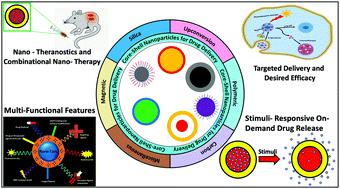当前位置:
X-MOL 学术
›
J. Mater. Chem. B
›
论文详情
Our official English website, www.x-mol.net, welcomes your
feedback! (Note: you will need to create a separate account there.)
Core-shell nanostructures: perspectives towards drug delivery applications.
Journal of Materials Chemistry B ( IF 6.1 ) Pub Date : 2020-08-10 , DOI: 10.1039/d0tb01559h Raj Kumar 1 , Kunal Mondal 2 , Pritam Kumar Panda 3 , Ajeet Kaushik 4 , Reza Abolhassani 5 , Rajeev Ahuja 6 , Horst-Günter Rubahn 5 , Yogendra Kumar Mishra 5
Journal of Materials Chemistry B ( IF 6.1 ) Pub Date : 2020-08-10 , DOI: 10.1039/d0tb01559h Raj Kumar 1 , Kunal Mondal 2 , Pritam Kumar Panda 3 , Ajeet Kaushik 4 , Reza Abolhassani 5 , Rajeev Ahuja 6 , Horst-Günter Rubahn 5 , Yogendra Kumar Mishra 5
Affiliation

|
Nanosystems have shown encouraging outcomes and substantial progress in the areas of drug delivery and biomedical applications. However, the controlled and targeted delivery of drugs or genes can be limited due to their physicochemical and functional properties. In this regard, core–shell type nanoparticles are promising nanocarrier systems for controlled and targeted drug delivery applications. These functional nanoparticles are emerging as a particular class of nanosystems because of their unique advantages, including high surface area, and easy surface modification and functionalization. Such unique advantages can facilitate the use of core–shell nanoparticles for the selective mingling of two or more different functional properties in a single nanosystem to achieve the desired physicochemical properties that are essential for effective targeted drug delivery. Several types of core–shell nanoparticles, such as metallic, magnetic, silica-based, upconversion, and carbon-based core–shell nanoparticles, have been designed and developed for drug delivery applications. Keeping the scope, demand, and challenges in view, the present review explores state-of-the-art developments and advances in core–shell nanoparticle systems, the desired structure–property relationships, newly generated properties, the effects of parameter control, surface modification, and functionalization, and, last but not least, their promising applications in the fields of drug delivery, biomedical applications, and tissue engineering. This review also supports significant future research for developing multi-core and shell-based functional nanosystems to investigate nano-therapies that are needed for advanced, precise, and personalized healthcare systems.
中文翻译:

核壳纳米结构:药物输送应用的前景。
纳米系统在药物输送和生物医学应用领域显示出令人鼓舞的成果和实质性进展。然而,药物或基因的受控和靶向递送可能因其物理化学和功能特性而受到限制。在这方面,核壳型纳米粒子是用于受控和靶向药物输送应用的有前景的纳米载体系统。这些功能纳米颗粒因其独特的优势而成为一类特殊的纳米系统,包括高表面积、易于表面改性和功能化。这种独特的优势可以促进核壳纳米颗粒的使用,在单个纳米系统中选择性混合两种或多种不同的功能特性,以实现有效靶向药物输送所必需的所需物理化学特性。几种类型的核壳纳米颗粒,如金属、磁性、二氧化硅基、上转换和碳基核壳纳米颗粒,已被设计和开发用于药物输送应用。着眼于范围、需求和挑战,本综述探讨了核-壳纳米颗粒系统的最新发展和进步、所需的结构-性能关系、新产生的性能、参数控制的影响、表面修饰和功能化,最后但并非最不重要的一点是它们在药物输送、生物医学应用和组织工程领域的有前景的应用。该综述还支持未来开发多核和基于壳的功能纳米系统的重要研究,以研究先进、精确和个性化医疗保健系统所需的纳米疗法。
更新日期:2020-10-14
中文翻译:

核壳纳米结构:药物输送应用的前景。
纳米系统在药物输送和生物医学应用领域显示出令人鼓舞的成果和实质性进展。然而,药物或基因的受控和靶向递送可能因其物理化学和功能特性而受到限制。在这方面,核壳型纳米粒子是用于受控和靶向药物输送应用的有前景的纳米载体系统。这些功能纳米颗粒因其独特的优势而成为一类特殊的纳米系统,包括高表面积、易于表面改性和功能化。这种独特的优势可以促进核壳纳米颗粒的使用,在单个纳米系统中选择性混合两种或多种不同的功能特性,以实现有效靶向药物输送所必需的所需物理化学特性。几种类型的核壳纳米颗粒,如金属、磁性、二氧化硅基、上转换和碳基核壳纳米颗粒,已被设计和开发用于药物输送应用。着眼于范围、需求和挑战,本综述探讨了核-壳纳米颗粒系统的最新发展和进步、所需的结构-性能关系、新产生的性能、参数控制的影响、表面修饰和功能化,最后但并非最不重要的一点是它们在药物输送、生物医学应用和组织工程领域的有前景的应用。该综述还支持未来开发多核和基于壳的功能纳米系统的重要研究,以研究先进、精确和个性化医疗保健系统所需的纳米疗法。











































 京公网安备 11010802027423号
京公网安备 11010802027423号